The beauty of South Korea goes beyond the urban wonders of Seoul, that much is true. Take a tour of other cities and/or towns, and you’ll most likely stumble upon vast flower fields — some of which stretch further than your eyes can see. From springtime blooms to year-round blossoms, there’s never a shortage of flower fields in South Korea to add to your itinerary. After all, every season brings in different flowers and landscapes. No wonder this lovely country is worth visiting any time of the year!
Also read: 20 Stunning Hanoks in South Korea You Can Book on Airbnb
Spring flowers to see around South Korea
1. Canola flower fields in Sanbangsan
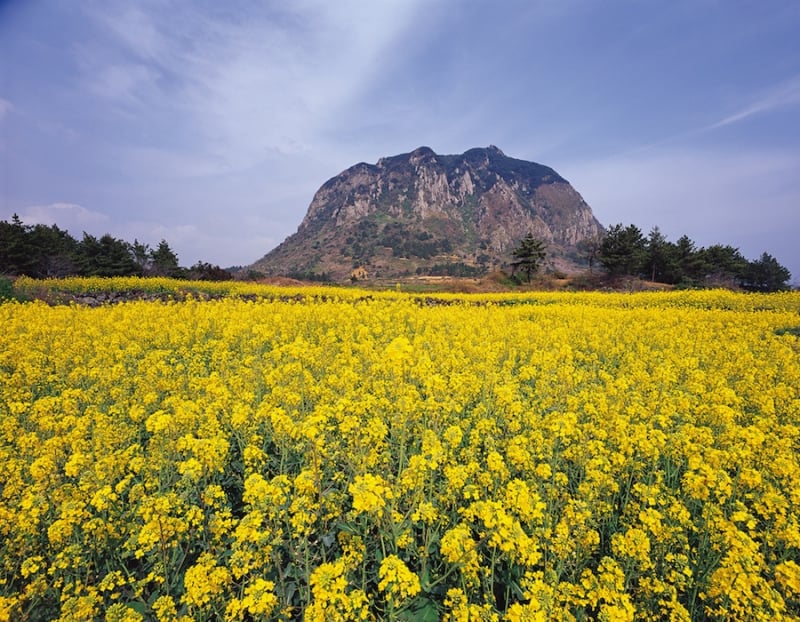
Image credit: Republic of Korea
Sanbangsan is a mountain on Jeju Island that was a result of volcanic activity from hundreds of thousands of years ago. Its name literally translates to “a cave inside a mountain.” But as far as springtime is concerned, the main attraction can be found at the base of this mountain. There, you’ll find it blanketed with a bright yellow coat — thanks to the canola flower fields!
The best time to see these spring flowers is from early March to late April. Oh, and there’s also the annual Jeju Canola Flower Festival held sometime within the first few weeks of April. But obviously, that was cancelled this year (as with many other spring events around the world)! (*sigh.*)
Also read: 15 Coolest Airbnbs in Jeju to Bookmark for Your Next Trip
2. Tulips and roses in Everland
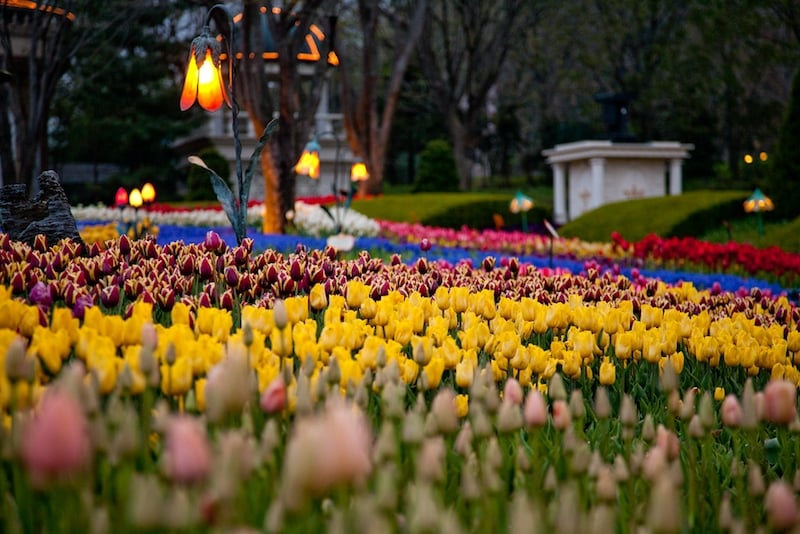
Image credit: jaeeun kim
As the largest theme park in South Korea, you’ll find many interesting attractions in Everland; from a wooden roller coaster and a mini-safari to breathtaking flower fields. Witness the Four Seasons Garden in full bloom, with more than a million flowers. Taking centre stage is the vast field of tulips and the rose garden! There are also sculptures and paths decorated with other spring flowers like daffodils, grape hyacinths, and freesias.
Visit between early March and mid-May to see most of the lovely flowers at their best. Everland also has a Tulip Festival held from mid-March to April! Then for the latter part of the season, there’s the Rose Festival held from mid-May till June.
Also read: 15 South Korea Theme Parks & Amusement Parks Worth Visiting
3. Plum blossoms in Gwangyang Maehwa Village
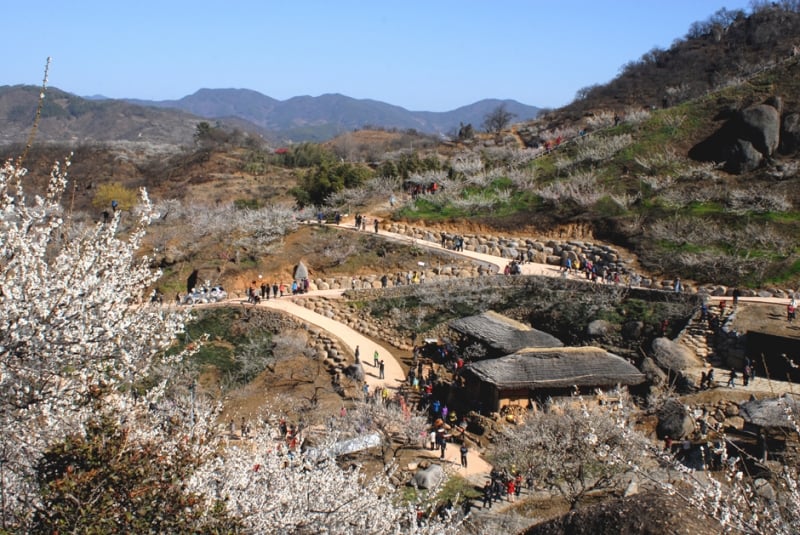
Image credit: Republic of Korea
You’ll find Seomjin Village tucked in the city of Gwangyang in Jeolla Province. In spring, this small yet charming village features postcard-worthy views brimming with plum trees! And from these trees sprout the plum blossoms (or maehwa), which gave the place its more common name: Gwangyang Maehwa Village.
These flowers are mostly white, making the place look like a snow-covered wonderland, even though winter is over. Though, there are also some plum blossoms in pink — making it look a lot like cherry blossoms!
See the splendour of plum blossoms during the Gwangyang Maehwa Festival, which is held mid-March. And while you’re at it, might as well try their famous plum-flavoured ice cream, too! Not a fan of sweets? Try the Maesil Ju (traditional Korean plum wine) instead!
4. Forsythia flowers in Eungbongsan
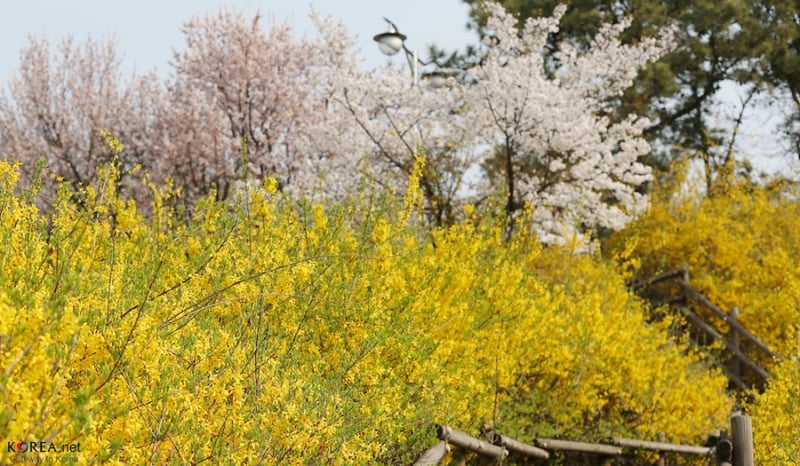
Image credit: Republic of Korea
For a blooming scenery that’s still within Seoul, head over to Eungbonsan — a mountain situated in the Seongdong district. Come springtime, this place gets blanketed with bright yellow, bell-shaped forsythia (or gaenari). It’s like a huge forsythia garden that’s absolutely stunning! The place is quite accessible, as the trails and steps are pretty easy to climb, even for kids. You can also spot some apricots and cherry blossom trees along the way.
The best time to visit is from late March to mid-April, around the same time as the Eungbongsan Forsythia Festival. Oh, and a fun fact: forsythia is the official flower of Seoul!
5. Azaleas in Wonmisan
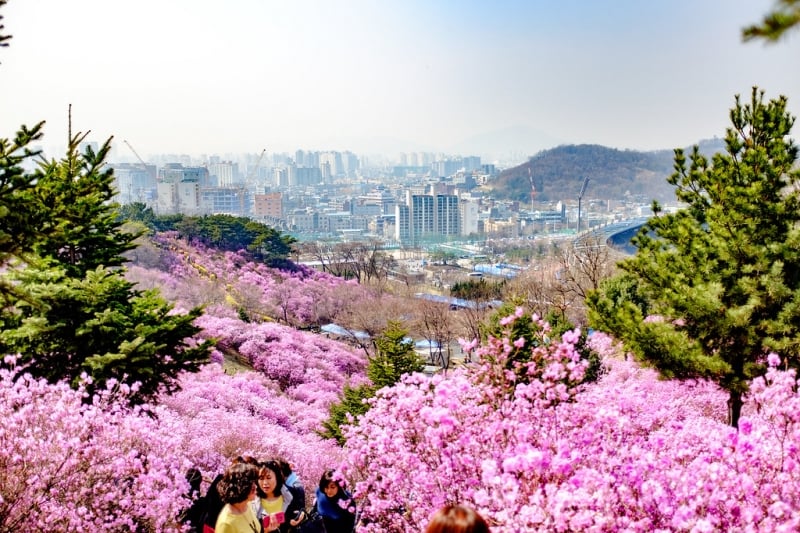
Image credit: 상수 김
Another nearby spot is the city of Buncheon, which is about a half-hour drive from Seoul! Make your way to the Wonmisan, a mountain that gets covered in a myriad of azaleas every spring. These vibrant flowers come in dreamy shades of pink, magenta, and lilac! What’s more — the place is also spacious enough, so there’s always a spot for you to take IG-worthy photos, even when it gets crowded.
The entire month of April up to mid-May is the most ideal time to check out this place. But for a surely picturesque scene, opt for mid-April, when the Wonmisan Azalea Festival is in full swing!
Also read: 18 Best Places to See Cherry Blossoms Outside Japan & South Korea
6. Various blooms in Byeokchoji Gardens
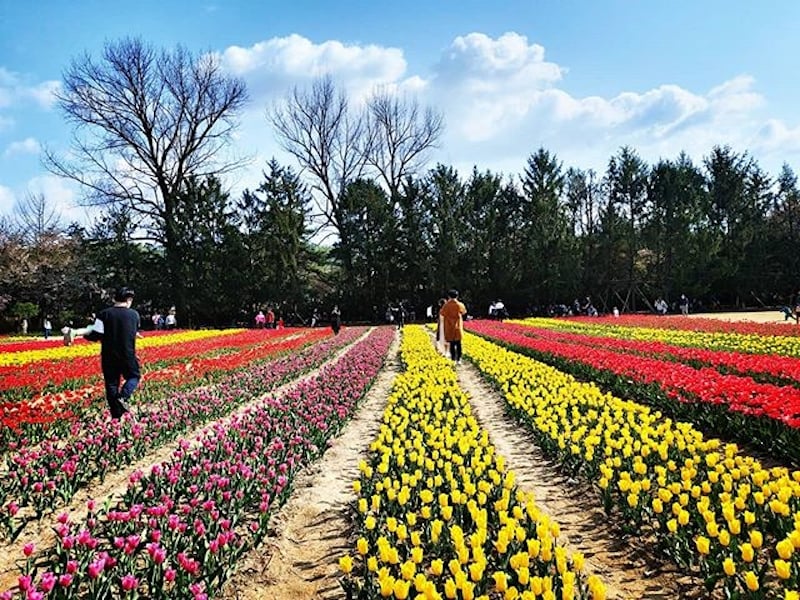
Image credit: Scene of Korea
For a whole lot of variety, Byeokchoji Gardens is your best bet! It has 27 themed gardens with both Oriental and Western landscaping elements, and over a thousand plant species. Some of the springtime flowers include coneflowers, tulips, daisies, periwinkles, calla lilies, and hydrangeas — though, these are just the tip of the iceberg!
Byeokchoji Gardens has also been used as a filming location for many Korean shows, such as My Love from the Star, Boys over Flowers, and Descendants of the Sun. Feel free to reenact some K-drama scenes while walking along these manicured flower fields in South Korea! Might as well, right?
Also read: 6 K-Drama Filming Locations Every Hardcore Fan Must Visit
Flower fields in South Korea to see in other seasons
7. Lavender fields in Hani Lavender Farm
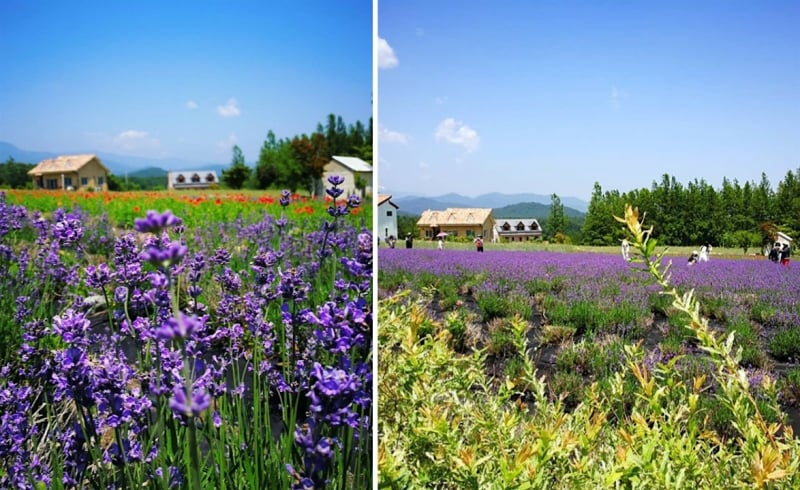
Image credit: Vicky Chen
As summertime arrives in South Korea, make sure you head east to Hani Lavender Farm in the province of Gangwon-do. There, you’ll see rolling hills of lavender, set against a lush backdrop of trees and mountains. It’s every bit as lovely as it looks — like it came straight out of a movie dream sequence! (And, yes, no need to go all the way to Europe just to see this spectacular sight).
The lavender fields sometimes start blooming as early as May, just as spring is ending. But if you want to be 100% sure, go in June when the flowers are at their best! It’s also when the farm hosts its annual Goseong Lavender Festival. Imagine strolling along rows of lavender bushes and breathing in the calming aroma that it’s well-known for. That said, don’t forget to bring home some lavender-infused products!
8. Sunflower patch in Taebaek
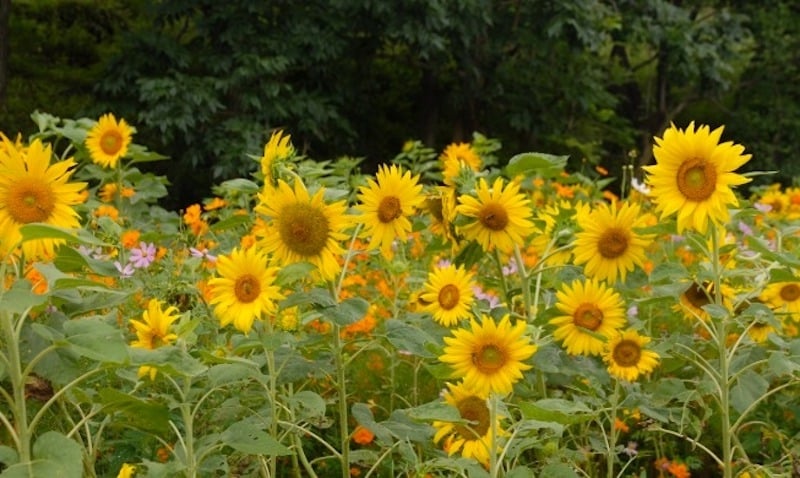
Image credit: Republic of Korea Official Website
Some of you might know Taebaek-si as one of the primary filming locations of the hit K-drama, Descendants of the Sun. But of course, there’s more to see and explore in this city in Gangwon-do — like the Taebaek Sunflower Festival, for instance! It’s held every summer in Guwau Village, which boasts a vast field of over 300 wildflower species.
Here, you’ll find the largest sunflower field in South Korea — how cool is that? Take it from us, walking around here will make you feel like you’re walking on sunshine. (And it’ll definitely feel good!). Anyway, the festival is often held between late July and mid-August, with the latter being the time when the sunflowers are in full bloom!
9. Buckwheat fields in Pyeongchang

Image credit: Gangwon Tourism Official Website
Another notable festival in Gangwon-do is the Hyoseok Cultural Festival, which takes place mainly in the Bongpyeong-myeon Culture Village in Pyeongchang-gun. This annual event is in commemoration of the Korean novelist, Lee Hyo-seok: best known for his work, When Buckwheat Flowers Bloom. That said, you can definitely expect to see stunning buckwheat fields that go as far as the eye can see; the same ones that inspired his writing.
Put on your prettiest picnic chic outfits and experience this fun-filled festival. It’s often held from early to mid-September! Apart from programs such as folk plays, various performances, and writing contests, you can also try out local speciality dishes made from buckwheat flour. Yum!
Also read: A 5-Day Gangwon, Korea Itinerary: Exploring this Breathtaking Coastal Province
10. Bright cosmos in Olympic Park
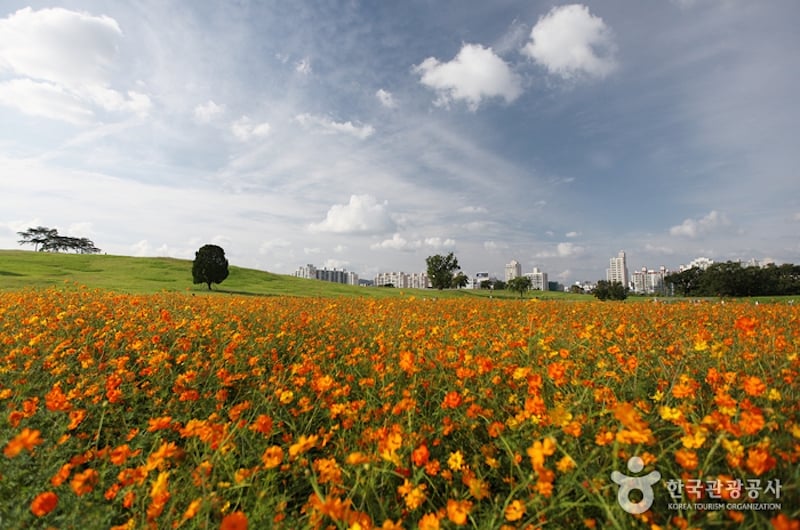
Image credit: Korea Tourism Organization Official Website
Sometime between late summer and early autumn, Seoul’s Olympic Park is painted in the most vibrant shades of pink and orange. This is largely thanks to the bright cosmos at the Wild Flower Garden. Originally built for the 1988 Summer Olympics, the park is now a go-to among locals to unwind and bask in natural scenery, without having to leave the city!
We also love how these cosmos flower fields can make you feel like you’re starring in a whimsical K-drama! Situated in Songpa-gu district, it’s certainly a must-visit spot if you’ll be in Seoul during mid-September to early October — i.e., when it’s still a bit too early for peak autumn foliage.
11. Fall flowers in Nari Park
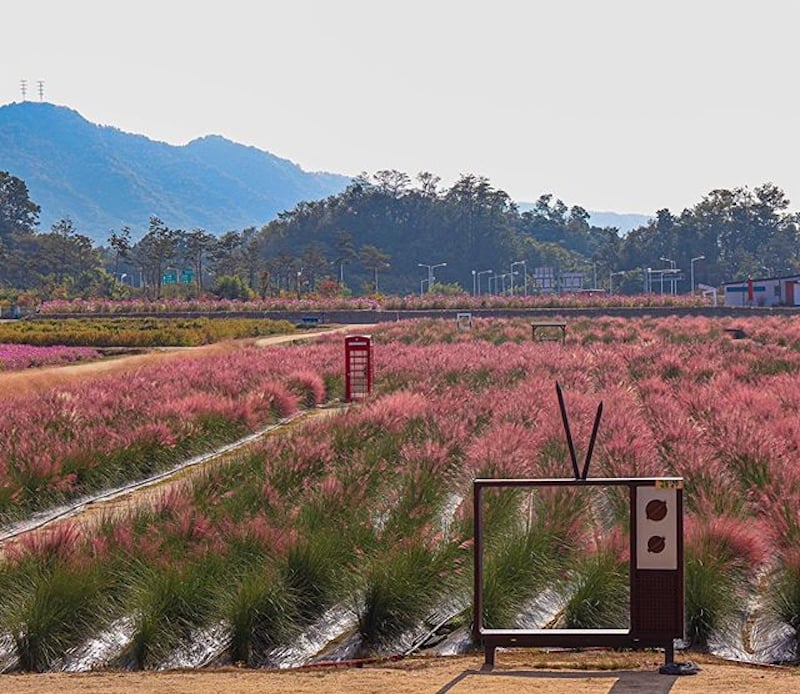
Image credit: 강 태원
Witness the autumnal splendour of Nari Park in vibrant shades ranging from deep red, violet, to light brown. Its grounds are brimming mostly with pink Muhly grass and Kochia scoparia bushes which are the stuff of #TravelGram dreams. Aside from these, there’s also an abundance of fall flower fields, featuring globe amaranths, Mexican asters, gaura wand flowers, and canna lilies.
Nari Park unveils its most beautiful side from late September till mid-October. Make the most out of the relatively fewer crowds and the plants still being mostly untouched. And if you can, try to visit in time for the sunrise or sunset. The sight of those fall blooms glistening against the rising and/or setting sun is all kinds of breathtaking!
Also read: 13 Spots to Find Pink Muhly in South Korea This Fall
12. Winter wonders in Camellia Hill
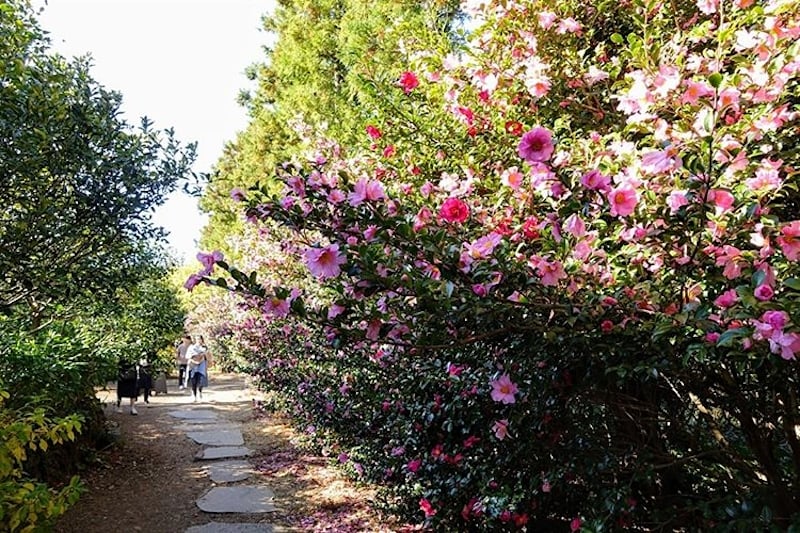
Image credit: Jeju Tourism Organization Official Instagram Page
Looks like we’re beginning and ending this article with another Jeju Island spot. This time, it’s the charming Camellia Hill! As its name suggests, it’s a garden filled with over 6,000 camellia trees — making it one of the largest in Asia. Apart from that, there are 500 species of seasonal flowers like poppies, roses, and hydrangeas. There’s also a Light Bulb Forest Path, which makes for a dreamy setting like those in your fave K-dramas.
Camellia Hill is truly worth visiting all year round. After all, camellias are one of the rare flowers that remain in full bloom, even during winter! That said, we recommend going there from late December to mid-February. The deep red camellias set amidst pure white snow is a sight to behold!
Also read: Why Do Travellers Love South Korea? Let Us Count The Ways
Don’t you just want to frolic in these pretty flower fields in South Korea? We know we do! More than anything, this list proves that there’s never a bad season to visit this country; from bright spring blooms to stunning autumn gardens, and everything in between! So, which of these colourful flower fields are you looking to explore next?





